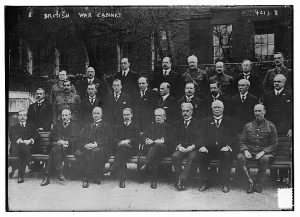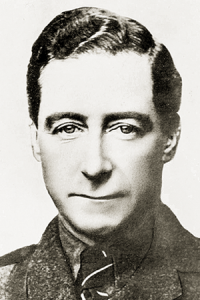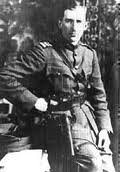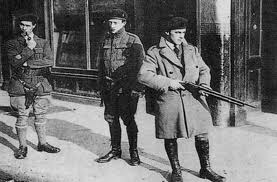Deliberate Amnesia? The Irish Volunteers’ plan to assassinate the British Cabinet, 1918.

The plan to wipe out the British government in 1918 and the subsequent attempt to forget it ever existed. By Fergus O’Farrell
In the spring of 1918, it looked increasingly likely that Britain would begin conscripting Irishmen into its army to fight in the Great War.
The Catholic Church, the labour movement, the Irish Parliament Party, Sinn Féin, the Irish Volunteers and a mass of public opinion were opposed to the measure. A general strike was held was held which brought most of Ireland to a standstill.
During the conscription Crisis of 1918, the Executive of the Irish Volunteers (the following year to be renamed IRA) met to discuss its response to the prospect of the British government introducing conscription in Ireland for the First World War. The Executive comprised 20 men, including Éamon de Valera, Seán McEntee Cathal Brugha and Richard Mulcahy.
The only member who was absent was Michael Collins, who was in prison[1]. At this meeting, it was decided that Cathal Brugha would lead a team of assassins to London where they would execute the British cabinet should the order to introduce conscription be given in parliament. It is most likely that Brugha was the mastermind of the scheme.
In April 1918, the Volunteer Executive ordered Cathal Brugha to lead a team to London to execute the British cabinet if they ordered that conscription be imposed on Ireland.
Brugha, Mulcahy and Dick McKee were responsible for recruiting the assassins. The hit squad arrived in London in April and remained there until the autumn. The tailed various government ministers around Whitehall, ready to kill them should conscription begin in Ireland.[2] Brugha even took one of his men up to the viewing gallery of the House of Commons to see if it would be possible to shoot the front bench from that vantage point.[3]
Developments on the Western Front and the German collapse meant that Irish conscripts were deemed unnecessary as the war played out over the final months of 1918. The assassins returned home, their powder dry, to take up other roles in the independence struggle. Within a few months of leaving Westminster, Brugha was presiding over the first meeting of Dáil Éireann.
We must question why the 1918 mission has been so absent from the historical narrative of this period and when it is mentioned, it is portrayed as a unilateral action taken on the initiative of a bellicose Brugha. The answer may be found in the attitudes of one time revolutionaries turned politicians and the manner in which they constructed and policed their archives.
Who issued the orders?

Brugha was the driving force behind the assassination plot. He was centrally involved in its planning and personally led the mission to London. However, it is important to point out that he had the backing of the Volunteer Executive. They unanimously endorsed the plan. One member of the Executive, Richard Walsh, explained to the Bureau of Military History (BMH) why the Executive signed the order to kill the government.
‘The document we signed authorising the expedition was drawn up in such a form that its publication would explain the reasons for the action and that the members of the Executive were taking full responsibility for issuing such an order as a representative Irish authority. As soon as the action planned was carried out in England, the document with the Executive member’s signatures was to be published in Ireland. This publication would be necessary to show the world that the men who carried out the operation were acting on the orders of the only body that then had the authority to authorize such actions on behalf of the Irish people, and that they were not just a crowd of gunmen acting on their own or taking orders from some unknown or obscure secret society.’[4]
Tomás Ó Dochartaigh, who published a biography of Brugha in 1969, also writes that a document was signed by the whole Executive. According to him, this document still exists, though he provides no footnote or clue as to where we might find it. It is much more likely that it was destroyed[5]
There is also evidence in the pages of An tÓglach, the newspaper of the Volunteers, which alludes to a consensus at the Executive level regarding the assassination plan. In September 1918, the editorial addressed conscription and stated that
‘the policy of the Irish Volunteers in such a contingency is, of course, a foregone conclusion. Never at any moment since the question first arose has there existed the slightest divergence of opinion among those in control of the Army of Ireland, nor among officers or men, as to their duty in case of an attempt by the enemy to enforce conscription in Ireland.’[6]
In the next issue, the paper reiterated its commitment to resistance: ‘In our last issue we stated clearly the unanimous decision of the Executive of the Irish Volunteers to resist conscription to the death with all the military force and warlike resources at our command.’[7]
The plan for the assassination of the British cabinet has been portrayed as the work of Cathal Brugha, but in fact it was ordered by the whole Volunteer Executive.
These statements from An tÓglach did not, for obvious operational reasons, reveal that a group of Volunteer assassins were ready to shoot the British government at that very moment. It is possible to argue that these statements in An tÓglach do not refer to the London mission, but rather to the other plans which the Volunteers had to resist conscription. However, when viewed alongside the other evidence in the BMH, it is quite credible that the Executive backed the plan.
If the plan had been carried out and the cabinet has been assassinated during wartime, it can be assumed that the British reaction in Ireland would have been extremely severe. It would also have triggered a major international crisis as the British were a key player in the Great War.
The Mulcahy archive.

Richard Mulcahy, in particular, has attempted to abjure his role in the mission. There are several reasons for this. Following the revolution, Mulcahy had a long career in politics with Cumman na nGeadheal and later Fine Gael, often viewed as the parties of law and order.
Revelations that he was centrally involved in a conspiracy to assassinate the British Cabinet in the closing stage of the First World War could have been extremely damaging to him. We must also consider the personal relationship between Brugha and Mulcahy.
Brugha, as Minister for Defence, sacked Mulcahy as IRA Chief of Staff in 1921, and the Treaty split drove a wedge further between the two men, ending with Brugha’s death at the hands of Free State troops, of whom Mulcahy was the Commander, in July 1922.
Trawling through his archive, it is clear that Mulcahy has attempted to construct a favourable portrait of himself and Collins, while he can sometimes be disparaging of Brugha. The Mulcahy archive is vast and all serious scholars of the Irish Revolution study it.
Richard Mulcahy later attempted to distance himself from the proposed assassination.
Brugha was a shadowy figure, who sought to remain unknown during the war. He was highly reluctant to commit anything to paper which may have been incriminating. It is inconceivable that he would have left evidence of his involvement in a plot to kill the British cabinet. No personal papers of Brugha’s survive. Thus, the historian is forced to look to his contemporaries to build a picture of the man. The Mulcahy papers are very useful in this regard.
In his extensive archive, Mulcahy often refers to Brugha’s wild schemes which he dreamed up autonomously and conducted independently of his colleagues in cabinet or his subordinates at GHQ. ‘Cathal Brugha did no systematic work in connection with the carrying on of the military organisation. The things that filled him at any time with active intent in which he himself was to be engaged, which stand out in any way were the trips to London.’[8]
Through his archive, Mulcahy has tried to influence historians’ interpretations of the revolution; he promotes the idea that himself and Collins were the crucial actors in forcing the British to a settlement and were at the heart at formulating military policy. In many respects, he is correct.
However, he has also attempted to discredit Brugha. He depicts Brugha as aloof, absent, angry and fastidious; a man who only became active when planning suicide missions to the House of Commons. The way in which Mulcahy has framed the 1918 mission in his archive is another example of his deliberate attempt to influence our understanding of events. Other evidence suggests that Mulcahy was intimately involved in the planning stages, and signed the assassination order, despite his attempt to sanitise his involvement in the mission in his archive.
Mulcahy has deliberately tried to minimise his own role, as well as the rest of GHQ/ Volunteer Executive in the plot. For example, in his detailed notes of Piaras Béaslaí’s biography of Collins,[9] Mulcahy has annotated that ‘it must be emphatically stated that Cathal Brugha was the greatest advocate of extreme and drastic action against the British Government. He even advocated certain measures which no other members of the Executive or GHQ favoured, and in pursuance of his ideas, had intelligence officers sent to London to report on the practicability of these measures.’[10]
Elsewhere, he writes that ‘He put me in a certain amount of difficultly when I found out that he was going to go over to London and that he wanted people to go with him for the assassinations over there; but that didn’t prevent me from looking for the men for him and talking about the type of people that would be got.’[11]
Mulcahy paints himself as a reluctant subordinate, who was ‘dragged’[12] into this grand conspiracy orchestrated by a deranged and often absent Brugha. Brugha revived the assassination plot against the British cabinet on two occasions later in the War of Indpendence.
Brugha revived the assassination plot against the British cabinet on two occasions later in the War of Independence.
In 1920, Brugha and Collins met with some Cork based IRA men at Vaughans Hotel and briefed them on the mission. It was abandoned when Republicans thought the British might be interested in negations to end the conflict.[13] In March 1921, Brugha summoned Séan MacKeon to Lalors, Brugha’s candle making factory, which doubled as his ministerial office. He informed him of the plan and explained his reasoning:
‘If you wiped out every Black and Tan in Ireland to-morrow, you’d have shiploads of them pouring in again, the day after! And if you wiped every soul of them out, double as many shiploads would come in, the day after that!…To save Ireland, you have got to wipe out the guilty ones who sent the Black and Tans here! We have got to wipe out every member of the British Cabinet.’[14]
MacKeon then went to see Collins, who told him to stop ‘thinking you are some vest-pocket Bonaparte going over to conquer England. Let me tell you that your mad plan was put before the Defence Council, and the Cabinet, and was scouted out.’[15] Relations between Brugha and Collins were highly strained by this stage. MacKeon was captured on his way back to Longford and the plan was once again abandoned as it looked more likely that truce arrangements were being made.
Referring to the 1921 revival of the mission, Mulcahy writes that ‘the latter plan was one that neither Collins nor myself approved of.’[16] This must beg the question: Did they approve of the first one in 1918?
The following is another attempt by Mulcahy to distance himself from the episode and to show that Brugha was acting alone, without sanction from or reference to the Volunteer Executive:
‘A situation had arisen which caused him to develop ideas of his own…..Cathal had apparently come to a very definite decision as to the part he intended to play. He asked me to get him from among the Volunteers some Volunteers to go to London with him on some dangerous work. His intention was that immediately the first positive act had taken place in Ireland to put conscription into force, he would personally lead an attack on individual members of the British Government responsible. He would make the plans himself and he would deal directly and personally with the persons Volunteering to go from Ireland. He would arrange his contacts in England. There was no room for discussion of the matter and at the moment there was no necessity. The Volunteers were brought and after Cathal had interviewed them he was in London by the 30th April [1918] to plan and await developments.’[17]

Significantly, there is no mention of Mulcahy or McKee in the interview process, despite several BMH contributors claiming that both Mulcahy and McKee were directly involved in the interviews.
Mulcahy concludes with: ‘it is a measure of his sense of what a disaster for Ireland an attempt to enforce conscription there would be, that he could think of no other way in which he could adequately express himself or be effective.’[18] This last line is a swipe at Brugha and is borne out of the animosity which Mulcahy harboured towards him.
If the cabinet has been assassinated during wartime, the British reaction in Ireland would have been extremely severe. It would also have triggered a major international crisis in the closing months of the Great War.
In 1967, Thomás Ó Dochartaigh contacted Mulcahy requesting to interview him about some articles he was intending to write on Brugha: that research was eventually published as an Irish language biography.[19] At the time, Mulcahy was writing historical articles on the revolution for the Capuchin Annual. In a telling note to himself (where he refers to Ó Dochartaigh as O’Dotherty), though in his somewhat convoluted style, Mulcahy writes:
‘evidently O’Dotherty is going to bring out the fact that Cathal was in London in 1918 on the anti-British cabinet job. This opens the door for taking cognisance of this in the Capuchin article … The O’Dothery articles will probably run for some time and will disclose 1. Some of the things that we may venture to include in the 1918 article about which when questions arise later, we may wish to have pre-mention of, and 2. Other matters that we will recognise as things that should wait and appear if necessary as surprise later.’[20]
Here Mulcahy is once again trying to distance himself from his involvement in the mission, and is considering to pre-empt possible assertions which Ó Dochartaigh may make which would implicate Mulcahy in the plot.
The size and importance of the Mulcahy papers mean that the Mulcahy view has sometimes worked its way into the historiography. Mulcahy’s son, Dr Risteárd Mulcahy, published a book about his father which downplayed his father’s role in the affair.[21] Maryann Valiulis’ biography of Mulcahy does not mention the assassination plot.[22] The way in which Mulcahy compiled his archive has contributed in a large part to our negligible and one sided understanding of this dramatic episode in Irish history.
Mulcahy is not the only historical figure who has sought to promote a favourable picture of himself to future researchers. Patrick Murray has demonstrated how de Valera sought to do the same, which amounted to a ‘defensive preoccupation with his history.’ Both men shared that preoccupation. Mulcahy ‘laboured for decades to provide a painstakingly detailed account of events in which he had been involved. His main conclusions were radically at variance with those of de Valera and his apologists, as well as with those of Collins’s official biographer, Piaras Béaslaí.’[23]
The assassination mission was aborted when the threat of conscription passed, but Brugha would return to the scheme on at least two occasions during the War of Independence, though the support of his colleagues would diminish for such action.
The scant attention which this episode has received in the historiography is symptomatic of Mulcahy’s efforts to downplay the incident and frame it as a scheme for which Brugha alone was responsible. No counter narrative or analysis has been offered. However, new sources like the BMH and more recently the Military Service Pension Collection can add to our understanding of this intriguing affair.
Fergus O’Farrell’s biography of Cathal Brugha is out in September 2018, published by UCD Press.
References
[1] Collins was arrested under the Defence of the Realm Act for a speech he had made in County Longford, allegedly urging his listeners to seize arms. He was released on bail two weeks later. Peter Hart, Mick, the Real Michael Collins, (2005) p. 159-168.
[2] Newspaper editors were also proposed as targets, but once in London the assassins focused their attention on ministers.
[3] For a more detailed account of what happened in London, see Fergus O’Farrell, Cathal Brugha: Life and Times New Series (2018).
[4] Irish Military Archives, Bureau of Military History, WS 400, Richard Walsh, 39-40.
[5] Tomás Ó Dochartaigh, Cathal Brugha: a shaol is a thréithe, (1969), 76.
[6] An tÓglach, 14 Sept 1918.
[7] An tÓglach, 30 Sept 1918.
[8] University College Dublin Archives, Richard Mulcahy, P7b/190.
[9] Piaras Béaslaí, Michael Collins and the Making of a New Ireland (Dublin, 1926).
[10] UCDA, Mulcahy, P7b/190
[11] UCDA Mulcahy, P7b/181
[12] Richard Mulcahy quoted in Risteárd Mulcahy, My Father, the General: Richard Mulcahy and the Military History of the Revolution (Dublin, 2009), 56.
[13] IMA, BMH, WS 1479, Sean Healy, 52.
[14] IMA, BMH, WS 1716, Sean MacKeon, 162.
[15] IMA, BMH, WS 1716, Sean MacKeon, 168; Padric Colum, Arthur Griffith (Dublin, 1959), 223.
[16] UCDA, Mulcahy, P7b/190.
[17] UCDA, Mulcahy, P7b/212.
[18] UCDA Mulcahy, P7b/212.
[19] Tomás Ó Dochartaigh, Cathal Brugha: a shaol is a thréithe (Cathair na Mart, 1969).
[20] UCDA, Mulcahy, P7b/216. Mulcahy note to himself 16 June 1967.
[21] Mulcahy, My Father, 134.
[22] Maryann Valiulis, Portrait of a Revolutionary: General Richard Mulcahy and the Founding of the Irish Free State (Dublin, 1992).
[23] Patrick Murray, ‘Obsessive Historian: Éamon de Valera and the Policing of his Reputation’, Proceeding of the Royal Irish Academy. Section C: Archaeology, Celtic Studies, History, Linguistics, Literature 10, no.2 (2001), 37-65.